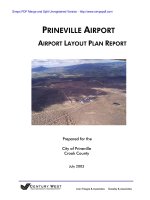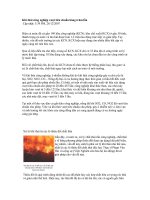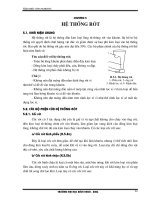PRINEVILLE AIRPORT AIRPORT LAYOUT PLAN REPORT phần 2 pps
Bạn đang xem bản rút gọn của tài liệu. Xem và tải ngay bản đầy đủ của tài liệu tại đây (231.93 KB, 15 trang )
CITY OF PRINEVILLE Prineville Airport
CROOK COUNTY Airport Layout Plan Report
AIRPORT LOCALE
Prineville Airport is located approximately three miles southwest of the City of Prineville, in
northwestern Crook County. Established in 1868, Prineville is the largest community and the
only incorporated city within Crook County. Prineville is also the county seat. Crook County,
located in the geographical center of Oregon, borders Jefferson and Wheeler counties to the
north; Deschutes County to the west and south; and Harney and Grant counties to the east. The
nearest major city is Bend, located approximately 35 miles southwest of Prineville. An airport
location map is provided in Figure 2-1.
Crook County is situated mainly within the Deschutes River Basin with a land area of 2,991
square miles (1,907,200 acres). The region is comprised mainly of farmland, rangeland, and
moderately mountainous terrain. The elevation at Prineville Airport is 3,250 feet above mean sea
level (msl).
Crook County’s primary north-south highway route is U.S. Route 97, which is approximately 18
miles west of Prineville. U.S. Route 26 provides a direct route from Portland to Prineville (147
miles southeast). U.S. Route 20 serves as the primary east-west route connecting Crook County
to Idaho (east) and Salem (west). Prineville Airport is located just north of State Route 126,
which provides a direct route from Prineville west to the Oregon coast. Recreational activities in
the local area include fishing, hunting, golf, skiing, hiking, and visiting historical sites.
CLIMATE
The geographical climate for Central Oregon is mainly High Desert. The climate of Crook
County is semi-arid, with annual precipitation varying from eight inches on the Deschutes
plateau to more than 19 inches in the high valleys used for agriculture. Detailed climatic data for
Prineville was available for a 29-year period between 1961 and 1990.
1
The average maximum
temperature is 86.6 degrees Fahrenheit (July) and the average minimum temperature is 21.7
degrees (December/January). Prineville averages 10.4 inches of precipitation and 12 inches of
snowfall annually. The daily extreme temperatures for Prineville are 34 degrees Fahrenheit
(December) and 105 degrees (July/August). The prevailing winds are for Prineville are primarily
from the northwest and the southeast.
July 2003 2-2 Inventory/Forecasts
Century West Engineering Aron Faegre & Associates Gazeley & Associates
1
Western Regional Climate Center.
CITY OF PRINEVILLE Prineville Airport
CROOK COUNTY Airport Layout Plan Report
FIGURE 2-1: LOCATION MAP
July 2003 2-3 Inventory/Forecasts
Century West Engineering Aron Faegre & Associates Gazeley & Associates
CITY OF PRINEVILLE Prineville Airport
CROOK COUNTY Airport Layout Plan Report
PHYSICAL CHARACTERISTICS
Crook County has an area of 2,991 square miles and encompasses the Blue Mountains along the
northern boundary, and the Maury Mountains to the south. The area is drained by the Crooked
River and is generally categorized as a broad high plateau with fertile valley, range and forest
lands typical of Central Oregon. Land ownership in the county is nearly equally divided between
private and government. Slightly less than half of Crook County is privately owned, primarily
farms and forestlands. Approximately the same amount of the County is in federal ownership,
including large areas of forestland administered by the U.S. Forest Service in the northern and
eastern sections of the county. The remaining federally owned land is managed by the BLM or
the Bureau of Reclamation. State- and county-owned lands account for less than 2 percent of the
Crook County’s land area.
The geologic history of eastern Crook County is one of recurrent episodes of volcanism that can
be traced back nearly 40 million years to early Tertiary time. Prineville Airport is located on top
of more recent basaltic lava flows a million years old, with the thickness varying anywhere from
ten to a hundred feet.
The terrain at the airport site is generally level. The soils in the vicinity of the airport were
recently mapped (not yet published in a soil survey) and are classified as Redmond ashy sandy
loams, moderately deep and well drained with 0 to 3 percent slope.
2
Surface gravel and cobbles
are found in many areas around the airport. The depth to the basalt bedrock is 20 to 40 inches.
Typical vegetation includes Idaho fescue, needleandthread, Sandberg bluegrass, basin big
sagebrush and western juniper. The area surrounding the airport is largely undeveloped
rangeland.
SOCIOECONOMIC CONDITIONS
Population
According to data compiled by the U.S. Census Bureau and Portland State University Center for
Population Research and Census, the population of Crook County was 19,182 in 2000.
Unincorporated areas account for 62 percent of the county’s population. The remaining 38
percent is in Prineville, Crook County’s only incorporated city, with a population of 7,356 in
2000.
July 2003 2-4 Inventory/Forecasts
Century West Engineering Aron Faegre & Associates Gazeley & Associates
2
U.S. Department of Agriculture (2001).
CITY OF PRINEVILLE Prineville Airport
CROOK COUNTY Airport Layout Plan Report
Overall population growth for both the city of Prineville and Crook County was approximately
36 percent between 1990 and 2000, which equals an annual average growth rate of approximately
3.1 percent. This growth was up sharply from the previous ten-year period between 1980 and
1990, where population growth averaged less than 1 percent per year for both Prineville and
Crook County.
According to published forecasts, the area’s recent population growth trend is expected to
continue, but at a more moderate pace in the future.
3
The current long-term forecasts project
Crook County’s population to increase to 31,752 by the year 2040. This represents an overall
increase of approximately 66 percent, or an annual average increase of approximately 1.3
percent. If current distributions continue, the population for Prineville would be expected to
increase to approximately 12,211 residents by 2040.
Economy
Crook County’s economy is comprised of forest products, livestock, manufacturing, agriculture,
recreation, and wholesale trade. According to the 2002 Regional Economic Profile for Central
Oregon, Crook County’s economy is most dependent on the lumber and wood products industry,
which accounted for 24 percent of the nonfarm employment and over 90 percent of
manufacturing employment in Crook County in 2000. Currently, Prineville has Oregon’s highest
per capita of manufacturing jobs. Beef cattle, wheat, and hays are the principal crops. The
average farm size is 1,759 acres. Hunting, fishing, skiing and tourism are secondary industries.
The largest individual employer in Crook County and third largest employer in Central Oregon is
Les Schwab Tire Centers, which employs close to 1,000 people in Prineville, its headquarters.
Les Schwab continues to grow and has expanded its Prineville facilities. Two new
warehouse/distribution centers were recently constructed east of the airport, increasing their total
warehousing facilities in Prineville to two million square feet. Les Schwab has a hangar and
currently bases two Cessna Citation business jets at Prineville Airport.
Other large manufacturers include Clear Pine Molding and American Pine Products, each
employing nearly 500 employees.
4
The county has begun diversifying its employment and
economic base, with an emphasis on growth in the trade sector. Other sources of jobs for the
county are in the government and trade industries. The 2000 average annual unemployment rate
in Crook County was 8.4 percent, well above the 4.9 percent statewide average. According to the
Oregon Employment Department, Crook County’s higher unemployment rate can be attributed to
3
State of Oregon, Office of Economic Analysis.
July 2003 2-5 Inventory/Forecasts
Century West Engineering Aron Faegre & Associates Gazeley & Associates
4
Central Oregon Area Profile, Economic Development for Central Oregon.
CITY OF PRINEVILLE Prineville Airport
CROOK COUNTY Airport Layout Plan Report
both the decline of the lumber and wood products coupled with the population growth over the
last decade.
Job growth in the next decade for Crook County is projected to be lower (10%) than in the rate
experienced in the 1990’s (24%). Most of the anticipated job growth is expected to occur
primarily in the non-manufacturing sector. The sectors expected to have the most growth are
trade (60 percent) and service (35 percent) industries. Employment within the manufacturing
sector, which includes the area’s traditional wood products employers, is projected to decline by
about 4 percent during this period.
Airport History
In 1931, the City of Prineville acquired title to a 160-acre tract just northeast of the present site
for the purpose of construction of an airport. In 1942, a new airfield, just across Highway 126
and to the west of the original airfield was established. During the next few years, many
improvements were made, including adding hangars. It was determined that there was a need for
an Airport Commission to coordinate efforts to make improvements at the airport. The first
Airport Commission was created in February 1946, by a joint resolution of Crook County and the
City of Prineville, for the purpose of “supervising certain property owned by said municipal
corporations.”
The current airport configuration was established in the early 1940’s. Through the years various
improvements were made to increase the efficiency and safety of the airport. These included the
lengthening and paving of Runway 15/33 in 1964, the addition of a low intensity lighted system
and another extension of Runway 15/33 in 1967, and the paving of the taxiway and parking area
in 1972. Runway 10/28 was paved in the late 1970’s.
On October 1, 1975, a three member Airport Commission was formed, with one commissioner
from the County Court, the second from the City Council, and the third selected from the general
public (preferably someone with an interest and expertise in aviation).
The airport area now consists of approximately 400 acres and was annexed into the Prineville’s
city limits in 1995. City water and sewer service was subsequently extended to the airport to
support airport development. In 1998, the current Airport Commission was created with five
appointed commissioners, selected by the County Court and City Council. Although the
management of Prineville Airport is a joint venture between the city and county, it is the County
Court that has the final authority in major decisions affecting the airport.
July 2003 2-6 Inventory/Forecasts
Century West Engineering Aron Faegre & Associates Gazeley & Associates
CITY OF PRINEVILLE Prineville Airport
CROOK COUNTY Airport Layout Plan Report
Airport Environment
Prineville Airport is located in Crook County, approximately three miles southwest of
Prineville’s city center, just north and west of State Route 126. Currently, all landside
developments (hangars, aircraft parking, services, etc.) are located at the east end of the airport
served by an access road that connects to State Route 126. According to information provided by
the local chamber of commerce, the airport has three industrial parks nearby with more than 100
acres of land zoned for heavy industry. Figure 2-2 includes a site map and existing conditions at
the airport.
AIRFIELD FACILITIES
Historically, Prineville Airport has served a variety of general aviation users, including business,
commercial, and government aviation. The United States Forest Service (USFS) and the Bureau
of Land Management (BLM) utilize the airport to support their operations. Figure 2-3 depicts a
detailed view of existing terminal area facilities at the airport, located at the east end of the
airport. Table 2-1 summarizes airport data.
TABLE 2-1
AIRPORT DATA
Airport Name/Designation Prineville Airport (S39)
Airport Owner City of Prineville and Crook County
Date Established 1942
Airport Category
National Plan of Integrated Airport Systems (NPIAS) General Aviation
FAA Airport Reference Code: B-II
Airport Acreage Approximately 400 Acres
Airport Coordinates N 44º17.22’ W 120º 54.23’
Airport Elevation 3,250 feet Mean Sea Level (MSL)
Airport Traffic Pattern
Configuration/Altitude
Left Traffic - 1,000 feet above ground level
July 2003 2-7 Inventory/Forecasts
Century West Engineering Aron Faegre & Associates Gazeley & Associates
CITY OF PRINEVILLE Prineville Airport
CROOK COUNTY Airport Layout Plan Report
FIGURE 2-2: SITE MAP
July 2003 2-8 Inventory/Forecasts
Century West Engineering Aron Faegre & Associates Gazeley & Associates
CITY OF PRINEVILLE Prineville Airport
CROOK COUNTY Airport Layout Plan Report
FIGURE 2-3: TERMINAL AREA FACILITIES
July 2003 2-9 Inventory/Forecasts
Century West Engineering Aron Faegre & Associates Gazeley & Associates
CITY OF PRINEVILLE Prineville Airport
CROOK COUNTY Airport Layout Plan Report
Runways and Taxiways
Prineville Airport has two paved, lighted runways (10/28 and 15/33) with the southern/eastern
runway ends configured in an “Open-V.” Runway 10/28 is the primary runway, oriented in an
east-west direction. Runway 15/33 is the airport’s secondary runway, oriented in a north-south
direction and intersecting Runway 10/28 near its north end. Both runways have basic markings,
although Runway 10/28 supports straight-in non-precision instrument approaches and should
have non-precision runway markings. The airport is an uncontrolled field, which effectively
limits operations to one runway at a time. Both runways utilize a standard left traffic pattern.
The southern/eastern ends of the two runways are connected by a single taxiway that provides
access between the runways and aircraft parking and hangar areas. At the Runway 33 end, the
taxiway splits into two separate sections with a connection at the end of the runway and
approximately 450 feet to the north. Aircraft hold lines are located on the access taxiway near
the Runway 28 and 33 thresholds.
The runways are not served with parallel taxiways. This requires aircraft to back-taxi on the
runways for departures on Runways 10 and 15 and following landing on Runways 28 and 33;
Runway 15/33 is also used to provide access to/from the west end of Runway 10/28. A small
aircraft holding area is located on the south side of the Runway 10 threshold. A small
taxiway/turnaround is located on the west side of the Runway 15 threshold that connects to
Runway 10/28. Tables 2-2, 2-3, and 2-4 summarize existing runway and taxiway facilities.
TABLE 2-2
RUNWAY 10/28 DATA
Dimensions 5,000 x 60 feet; Aircraft Turnaround at Runway 10 end
Effective Gradient .02%
Surface Asphalt
Weight Bearing Capacity (WBC) 30,000 pounds – Single Wheel Landing Gear
1
Marking Basic (runway numbers, centerline stripe)
Lighting
Medium Intensity Runway Edge Lighting (MIRL); Threshold Lights;
Visual Approach Slope Indicator (Rwy 28)
Wind Coverage
99.3 percent (All Weather) with a 12 mph crosswind; combined
coverage with Rwy 15/33: 99.9%. Data: 8/00-7/01
1. Pavement Strength as published in U.S. Airport/Facility Directory
July 2003 2-10 Inventory/Forecasts
Century West Engineering Aron Faegre & Associates Gazeley & Associates
CITY OF PRINEVILLE Prineville Airport
CROOK COUNTY Airport Layout Plan Report
TABLE 2-3
RUNWAY 15/33 DATA
Dimensions 4,000 x 40 feet; Aircraft Turnaround at Runway 15 end
Effective Gradient .015%
Surface Asphalt
Weight Bearing Capacity (WBC)
5,000 pounds (limited to 5,000 pounds by airport operator) – Single
Wheel Landing Gear
1
Marking Basic (runway numbers, centerline stripe)
Lighting Low Intensity Runway Edge Lighting (LIRL); Threshold Lights
Wind Coverage Approximately 97.4 percent at 12 mph
1. Pavement Strength as published in U.S. Airport/Facility Directory
TABLE 2-4
TAXIWAY DATA
Taxiway
Dimensions/Configuration
Main Access Taxiway
Dimension/Description
2,950 x 35 feet. Access to apron and hangar areas from
Runway 28 & 33 ends.
Surface
Asphalt
Marking
Centerline stripe; hold lines.
Lighting/Reflectors
None
Runway-Parallel Taxiway Separation
N/A
Other Taxiways
Runway 15 Access Taxiway/Turnaround
190 x 30 feet. Asphalt surface.
Runway 33 Connecting Taxiway
415 x 35 feet. Bituminous Surface Treatment (BST).
Agricultural Area Access Taxiway
550 x 20 feet. Gravel surface.
South T-Hangar Access Taxiway
240 x 20 feet. Asphalt surface.
During a recent site visit, the runways and taxiway appeared to be in fair condition. Aircraft
parking aprons ranged from good to poor condition. Sections of pavement around the aircraft
fueling area appeared to be in poor condition. It was observed that the runway numbers and
other markings on the runways and taxiway were in fair condition.
A wind study for Runway 10/28 was completed in September 2001. Data was collected
beginning in August 1, 2000 through July 31, 2001. The data indicates that Runway 10/28
provides 99.3% wind coverage with a 12 mph crosswind. Runway 10/28 meets FAA wind
coverage requirements for small runways. Local pilots indicate that Runway 10/28 is the calm
July 2003 2-11 Inventory/Forecasts
Century West Engineering Aron Faegre & Associates Gazeley & Associates
CITY OF PRINEVILLE Prineville Airport
CROOK COUNTY Airport Layout Plan Report
wind runway, with take-offs on Runway 28 and landings on Runway 10. Runway 15/33
provides additional crosswind coverage for smaller aircraft.
Aircraft Apron
Prineville Airport has two aircraft parking aprons located at the east end of the airport. The
aprons provide parking for permanently- and seasonally-based aircraft and itinerant aircraft.
Table 2-5 summarizes existing apron facilities at the airport.
TABLE 2-5
AIRCRAFT APRON DATA
Terminal Apron
Approximately 540 x 170-230 ‘ (varies) (12,650 square yards)
Light aircraft tiedowns, aircraft fueling.
Asphalt Concrete
Central Apron
Approximately 595 x 210’ (13,950 square yards)
Light aircraft tiedowns, SEAT Ground Operations
Asphalt Concrete
Hangar Apron
(Fronting Les Schwab Hangar)
Approximately 340 x 65 ‘ (2,700 square yards)
Temporary aircraft parking, aircraft fueling.
Coal Tar Seal over Asphalt Concrete
USFS Helicopter Parking Pad (1)
Hard Surfaced Pad
BLM Helicopter Parking Pads (2)
Hard Surfaced Pads
Helicopter Parking Area
Unimproved Surface (adjacent to AG Apron)
AG Aircraft Apron
Hard Surfaced Pad (north side of Runway 10/28)
The main terminal apron is located at the south end of the terminal area with the fixed base
operator (FBO)/general aviation terminal building, the aircraft fueling area, and several
conventional hangars located adjacent to the apron. The terminal apron is configured with
several rows of light aircraft tiedowns, although larger business itinerant aircraft also park on the
apron. A compass rose is painted on the apron near the aircraft fueling area. Based on the most
recent pavement evaluation, the condition of the terminal apron ranges from failed (near the fuel
area) to excellent directly in front of the FBO.
A second larger apron is located near the center of the terminal area, which is also configured
with several rows of aircraft tiedowns. The northern end of the central apron is used for the
single engine air tanker (SEAT) aircraft parking and ground operations associated with seasonal
July 2003 2-12 Inventory/Forecasts
Century West Engineering Aron Faegre & Associates Gazeley & Associates
CITY OF PRINEVILLE Prineville Airport
CROOK COUNTY Airport Layout Plan Report
fire response activities. The central apron pavement was rated as very good to excellent during
the last inspection. Both aprons are connected to the main access taxiway.
Helicopter parking on the airport includes three designated areas for aircraft used by BLM or
USFS. Other itinerant helicopters park on the aircraft aprons in the terminal area.
Agricultural Aircraft Facilities
Prineville Airport has a designated agricultural (AG) aircraft loading area located on the north
side of Runway 10/28, near the Runway 28 end. The AG area includes one 30 x 30’ concrete
loading pad and a taxiway that connects to the end of Runway 28. Vehicle access to the AG area
is provided by gravel roadways connecting to the main airport access road.
Airfield Pavement Condition
As part of the Oregon Aviation System Plan, the Oregon Department of Aviation manages a
program of pavement evaluation and maintenance for Oregon’s general aviation airports. This
evaluation provides standardized pavement condition index (PCI) ratings, pavement features and
current conditions. Through the use of MicroPAVER computer software, current pavement
condition ratings are entered into the system with the specifics of each pavement section. The
program is able to predict the future condition of the pavements if no action is taken (i.e. rate of
deterioration) while also identifying the recommended measures needed to extend the useful life
of the pavement section.
Table 2-6 summarizes airfield pavement conditions for Prineville Airport based on the most
recent inspections conducted in 2000. During the most recent pavement inspection, the ratings
for the pavements ranged from “excellent” to “failed”. Runway 15/33 was rated excellent based
on the overlay project completed in 2000. Currently, the average PCI for all airfield pavements
at Prineville is 70, which is rated “good.”
July 2003 2-13 Inventory/Forecasts
Century West Engineering Aron Faegre & Associates Gazeley & Associates
CITY OF PRINEVILLE Prineville Airport
CROOK COUNTY Airport Layout Plan Report
TABLE 2-6
SUMMARY OF AIRFIELD PAVEMENT CONDITION
(AUGUST 2000)
Pavement Section Design/Age PCI Rating
1
Condition
Runway
10/28
2” AC (1980). Eastern 3,155-foot section
3” Crushed Aggregate (1980); 3.5”
Aggregate (1966); Western 1,845-foot
section 6” Crushed Aggregate (1980).
72 (West Section)
65 (East Section)
92 (Rwy 10 turnaround)
Very Good
Good
Excellent
Runway
15/33
1.5” AC (2000); 1” Cold Mix AC (1990 -
southeast 2,870 feet only); TBST Cinder
Mat (1960); 6” Aggregate (1960).
100 (Southeast Section)
100 (Northwest Section)
54-80 (North end Rwy 15)
Excellent
Excellent
Fair to Very Good
Access
Taxiway
2” AC (1988); 6” Crushed Aggregate
(1988).
54 (Main taxiway)
0 (Rwy 33 connector)
Fair
Failed
Terminal
Apron
1.5 to 3” AC (1960-1991); 2-6” Aggregate
or Crushed Aggregate (1960-1991).
30 (Southeast Section)
90 (FBO Section)
6-72 (North Section)
Poor
Excellent
Failed to Very Good
Central
Apron
2” AC (1991) main apron; north & south
extensions (2000). Various depth of pit
run or Crushed Aggregate (1991 & 2000).
83 (Main Apron)
100 (North & South
Extensions)
Very Good
Excellent
1. The Pavement Condition Index (PCI) scale ranges from 0 to 100, with seven general condition categories ranging from
“failed” to “excellent.” For additional details, see Oregon Aviation System Plan Pavement Evaluation/Maintenance
Management Program for Prineville Airport.
LANDSIDE FACILITIES
Hangars and Airport Buildings
In early 2003, the airport had eleven conventional hangars, three T-hangars, and one
conventional/T-hangar. The hangars are used primarily for aircraft storage. Other facilities
include an airport maintenance equipment storage building, an airport terminal/FBO building,
and a caretaker residence.
The Interagency Fire Dispatch Center is located on the airport, adjacent to the terminal area. The
facility is used for coordinating wildfire response crews throughout central Oregon and includes
operations and equipment storage buildings. Another non-aviation building is located on east
side of the airport access road. The building is used primarily for equipment storage and
July 2003 2-14 Inventory/Forecasts
Century West Engineering Aron Faegre & Associates Gazeley & Associates
CITY OF PRINEVILLE Prineville Airport
CROOK COUNTY Airport Layout Plan Report
maintenance. Existing airport buildings are summarized in Table 2-7. The identification
numbers listed for each building correspond to the buildings depicted in Figure 2-3, on Page 2-9.
TABLE 2-7
AIRPORT BUILDINGS
Building ID No.
(See Figure 2-3)
Building Existing Use
1T-Hangar Aircraft Storage
2Conventional Hangar Aircraft Storage
3Conventional Hangar Aircraft Storage
4Conventional Hangar Aircraft Storage
6Interagency Fire Dispatch Buildings Operations, Equipment Storage
7 Large Conventional Hangar (Quonset) Aircraft Storage
8 Conventional Hangar Aircraft Storage, Maintenance
9Airport Terminal/FBO Building FBO office, terminal
10 Airport Maintenance Building Airport Maintenance Equipment Storage
11 Non-Aviation Building Equipment Storage, Maintenance
13 Large Conventional Hangar (Les Schwab) Aircraft Storage
14 Conventional Hangar Aircraft Storage
15
Conventional Hangar (Peverrieri)
Aircraft Storage
16
Conventional Hangar (Riley)
Aircraft Storage
17
Conventional Hangar (EAA)
Aircraft Storage
18
T-Hangar (Zerbe)
Aircraft Storage
19
T-Hangar (Zerbe) Aircraft Storage
21 T-Hangar/Conventional Hangar (C&V)
Aircraft Storage
22 Conventional Hangar (Grizzly Mtn.)
Aircraft Storage
25 Caretaker Residence Residence
Airport Lighting
Prineville Airport accommodates day and night operations. Both runways are equipped with
edge lighting and threshold lights; Runway 28 is equipped with a visual guidance indicator
(VGI). These lights are pilot-activated on the radio frequency 122.8 MHz.
The airport has a lighted wind cone located near the intersection of the two runways. A second
unlighted wind cone is located near the terminal apron and the end of Runway 33. The airport
beacon is mounted on a wooden tower on the south side of the taxiway between the fuel pump
island and the airport maintenance storage building in the terminal area. Table 2-8 summarizes
existing airport lighting at Prineville Airport.
July 2003 2-15 Inventory/Forecasts
Century West Engineering Aron Faegre & Associates Gazeley & Associates
CITY OF PRINEVILLE Prineville Airport
CROOK COUNTY Airport Layout Plan Report
Runway 10/28 has medium intensity runway edge lighting (MIRL) and Runway 15/33 has low
intensity runway edge lighting (LIRL). The runway edge lights are set on a dusk-to-dawn
automatic switch. The runway lights are generally in good condition, although during a recent
site visit, several threshold lights on Runway 33 were observed to be broken. Local pilots
indicate that powered parachutes and ultra-lights occasionally land short of the runway damaging
these lights.
The taxiway does not have any lighting or edge reflectors. Some limited overhead lighting is
available in the aircraft hangar area, with building- or pole-mounted floodlights.
Local pilots that attended the joint planning conference for this project requested that visual
guidance indicators (VGI), such as visual approach slope indicators (VASI) or precision
approach path indicators (PAPI) be provided on Runway 10.
TABLE 2-8
AIRPORT LIGHTING
Component Type Condition
Runway 10/28 Edge Lighting Medium Intensity Runway Edge Lighting (MIRL) Good
Runway 15/33 Edge Lighting Low Intensity Runway Edge Lighting (LIRL) Fair
Taxiway Lighting or Reflectors None N/A
Lighted Airfield Signage None N/A
Visual Guidance Indicators Visual Approach Slope Indicator (VASI) – Rwy 28 Good
Airport Lighting Airport Rotating Beacon; Lighted Wind Cone Good
AIRSPACE AND NAVIGATIONAL AIDS
Prineville Airport operates under visual flight rules (VFR) and instrument flight rules (IFR)
conditions. The airport has two published global positioning system (GPS) instrument
approaches, one non-directional beacon (NDB) approach and a published Departure Procedure
(DP). The fixed base operator provides limited weather information, but the airport does not
have certified 24-hour weather data available. The instrument approaches for Prineville require
the use of the Roberts Field altimeter setting. The airport has no ground-based electronic
navigational aids. Table 2-9 summarizes existing navigational aids and related items.
July 2003 2-16 Inventory/Forecasts
Century West Engineering Aron Faegre & Associates Gazeley & Associates









